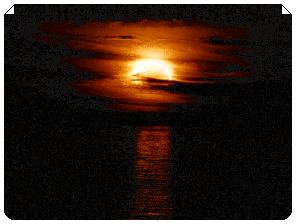
 Ancient Calendars |
 Ancient Observatories |
THE MOON IN ANCIENT HISTORY
| Five
hundred million years ago, the Moon summoned life out of its first
home, the sea, and led it onto the empty land. For as it drew the tides
across the barren continents of primeval earth, their daily rhythm
exposed to sun and air, most creatures of the shallows perished—but
some adapted to the new and hostile environment. The conquest of the
land had begun. |
|
 |
We shall never know when this happened, on the shores of what vanished sea. There were no eyes or cameras present to record so obscure, so inconspicuous an event. Now, the Moon calls again—and this time life responds with a roar that shakes earth and sky. |
| By Arthur C. Clarke. "L'envoi" from the epilogue of "First on the Moon". | |



|
Ancient cultures considered the flow of time to be a circle without beginning or end. Since people were mostly farmers, hunters and shepherds, they lived and worked closer to nature than in ages past. It was important that they knew the 'lore of the land' just to survive. They observed that the various phases the moon passed through in a month coincided with events transpiring in their environment. To this end, they learned to plant, fish, harvest, hunt, and make predictions, all by the light of the silvery moon. Humanity
seemed very little in control of the divine laws of nature. There were
major and minor cycles of experience, and the mysteries of the heavens
were a revelation of some divine principle of which they were a part.
The ebb and flow of the seasons reflected life as a whole, in life,
death, growth, rebirth and change. This was revealed to humanity in the
metaphor of the Gods. They also paid careful attention to the eclipses of the Sun and Moon.
Their basic assumption was that there is a sequence of consequences
between events in the heavens and events occurring on the earth. ("As
above, so below".) These observations formed the universal laws that
are the foundations of ancient wisdom.
Studying these observations also meant that precise measurements needed to be kept and observatories needed to be established to measure these cycles. Refer to the following links: |

|
The Moon and the Sun have been charged with certain attributes ever since the dawn of time. The Moon was the first universal measurer of time. The Moon symbolizes time, fate, spinning, wheels, weaving, cauldrons, and of course the Great Mother or feminine influence. The cycles of the heavens are symbolized
in the Medicine Wheel of the American Indian Tribes; the Egyptian Wheel
of the Law; and the Tibetan Prayer Wheel, all of which the Moon is an
integral part. In Astrology, the Moon is sometimes said to symbolize
the horoscope itself. And of course it rules the astrological sign of Cancer. |
|---|

Moon Pages (Navigation Bar) |
|||
|---|---|---|---|
 The Moon The Moon in Modern History |
Moon & its History
| ||
 Moon Legends Moon Legends and Tales |
in the Arts
| ||

|
All Rights Reserved Click here for Copyright information |
A member of  |
|
 |
||